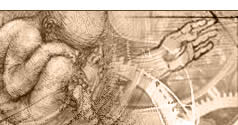 |
 |
 |
 |
 |
 |
 |
 |
|
 |
 |
 |
64 Microwave background radiation
|
| Menu | back |
The cosmic microwave background radiation coming to us from all directions in space is much more uniform than would be expected based on the big bang theory. With the introduction of dark matter, it was finally possible to explain the small measured irregularities with the predicted values. However, the existence of dark matter is still speculation.
In 1926, Sir Arthur Eddington argued that all celestial bodies are bathed in star light and that interstellar space must therefore have a temperature of approximately 3 K (-270°C) (1). After him, George Gamow interpreted this cosmic background radiation as an afterglow from the big bang. He calculated a figure of 5 K (-268°C). In 1961, he revised his figures predicting 50 K (2). In 1964, the two astronomers Arno Penzias and Robert Wilson finely measured a temperature of 2.7°K.
Later, NASA constructed a special satellite to map the entire cosmos using microwave background radiation. According to the big bang theory, the irregularities in the expansion of hydrogen and helium should have caused the large structures in the universe. However, the first satellites instruments proved to be too insensitive to measure any differences at all.
Then, a new satellite was built equipped with instruments, which were thirty times more sensitive. Subtle differences were, in fact, then noted. However, unpleasant surprises were also found. For example, it was found that the cosmos has a North and South Pole and an Equator (3). This, for its part, could mean that the universe has a centre and that we are close to this centre. In the big bang model, these results could not be understood because it is assumed that the universe does not have a centre.
Moreover, astronomer Tom Van Flandern believes that the absorption of microwaves in intergalactic medium and the absence of the effects of gravitational lenses contradict the big bang model (4).
Considering the erroneous predictions of the big bang theory (the exceptional uniform structure of microwave background radiation) and the alternative interpretations of the microwave background, it is necessary to critically consider the big bang theory in its entirety.
Philosophy | Menu |
back
|
References:
|
| (1) |
Arthur S. Eddington, The Internal Constitution of the Stars, New York: Dover Publications, 1926, republished 1959, page 371. |
| (2) |
Tom Van Flandern, The Top 30 Problems with the Big Bang, Apeiron, 9(2) 2002, pages 7290. |
| (3) |
David Whitehouse, Map Reveals Strange Cosmos, BBC News, 3. März 2003, http://news.bbc.co.uk/2/hi/science/nature/2814947.stm . |
| (4) |
Tom Van Flandern, Dark Matter, Missing Planets and New Comets: Paradoxes Resolved, Origins Illuminated, Berkeley, CA: North Atlantic Books, 1993, pages 100107. | |
| |
Comment this Site!
|
 |
 |
 |
 |
|

